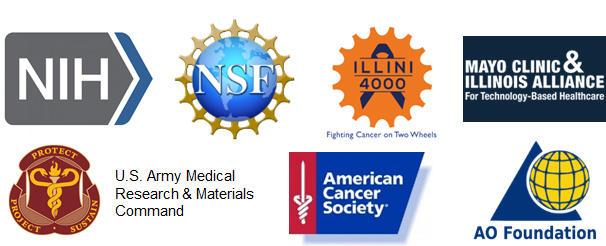figure acknowledgements: Genin et al., Biophys. J., 2009. Servier.
Musculoskeletal and Craniofacial Tissue Regeneration
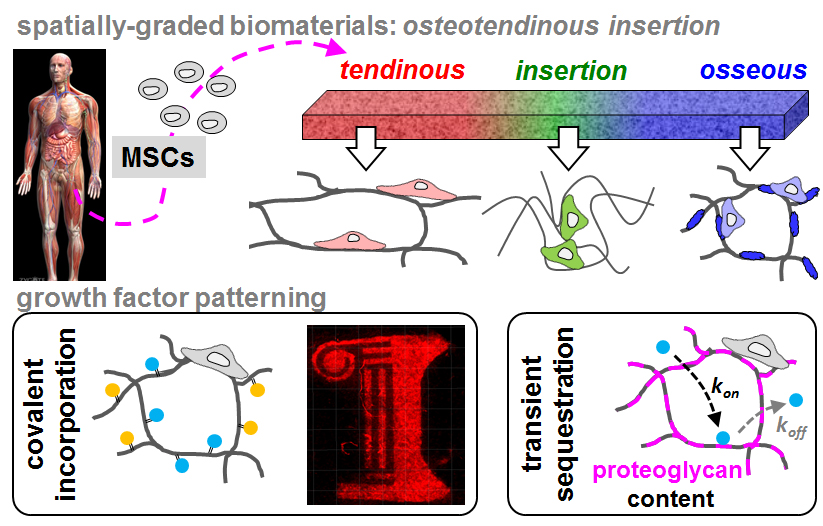 Injuries to spatially-ordered tissues in the musculoskeletal system present unique challenges to the field of tissue engineering. The osteotendinous interface connects tendon to bone via a complex insertional zone. The inability to regenerate this interface after injury leads to poor healing and high re-failure rates. A long-term objective in my lab is to develop biomaterials that address current barriers to osteotendinous regeneration. Our efforts concentrate on collagen biomaterials to direct mesenchymal stem cell (MSC) differentiation down multiple osteotendinous lineages in a spatially-selective manner. Such a construct could be seeded with the patient’s own stem cells then implanted to regenerate the interface. Our approach to promote multi-lineage differentiation of MSCs in a spatially-controlled manner is an innovative departure from the current state-of-the-art that emphasize mechanical rather than regenerative fixation.
Injuries to spatially-ordered tissues in the musculoskeletal system present unique challenges to the field of tissue engineering. The osteotendinous interface connects tendon to bone via a complex insertional zone. The inability to regenerate this interface after injury leads to poor healing and high re-failure rates. A long-term objective in my lab is to develop biomaterials that address current barriers to osteotendinous regeneration. Our efforts concentrate on collagen biomaterials to direct mesenchymal stem cell (MSC) differentiation down multiple osteotendinous lineages in a spatially-selective manner. Such a construct could be seeded with the patient’s own stem cells then implanted to regenerate the interface. Our approach to promote multi-lineage differentiation of MSCs in a spatially-controlled manner is an innovative departure from the current state-of-the-art that emphasize mechanical rather than regenerative fixation.
Engineered Bone Marrow
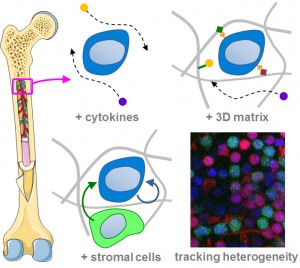 Hematopoiesis is the process where a small number of hematopoietic stem cells (HSCs) generate the body’s complement of blood and immune cells. These events take place in unique parts of the bone marrow termed niches. An artificial marrow has significant clinical value to improve treatment of hematopoietic diseases. We are developing biomaterials which provide the correct sequence of signals to grow HSCs in the laboratory. We have developed an engineered bone marrow biomaterial platform to examine the coordinated impact of niche-inspired signals on HSC behavior outside of the body. These platforms can be used as advanced stem cell biomanufacturing platforms as well as to study the onset and treatment of hematopoietic diseases.
Hematopoiesis is the process where a small number of hematopoietic stem cells (HSCs) generate the body’s complement of blood and immune cells. These events take place in unique parts of the bone marrow termed niches. An artificial marrow has significant clinical value to improve treatment of hematopoietic diseases. We are developing biomaterials which provide the correct sequence of signals to grow HSCs in the laboratory. We have developed an engineered bone marrow biomaterial platform to examine the coordinated impact of niche-inspired signals on HSC behavior outside of the body. These platforms can be used as advanced stem cell biomanufacturing platforms as well as to study the onset and treatment of hematopoietic diseases.
Mimicking the Tumor Microenvironment
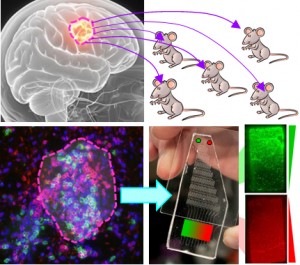 Glioblastoma multiforme (GBM) is a common and aggressive form of brain cancer with poor clinical prognosis. In vivo models and pathology metrics are the current gold standard for assessing malignancy and therapy. Biomimetic tissue engineering systems offer promise for advancing cancer research. Biomaterial models to examine the role of the spatially-heterogeneous tumor microenvironment are currently non-existent, but could overcome a number of barriers associated with current best-practices and provide new richness to our understanding of the etiology, growth, and treatment of GBM. Glioma avatars may have significant impact as personalized medicine tools for rapid, cost-effective, and rigorous assessment of malignant phenotype at the point-of-care.
Glioblastoma multiforme (GBM) is a common and aggressive form of brain cancer with poor clinical prognosis. In vivo models and pathology metrics are the current gold standard for assessing malignancy and therapy. Biomimetic tissue engineering systems offer promise for advancing cancer research. Biomaterial models to examine the role of the spatially-heterogeneous tumor microenvironment are currently non-existent, but could overcome a number of barriers associated with current best-practices and provide new richness to our understanding of the etiology, growth, and treatment of GBM. Glioma avatars may have significant impact as personalized medicine tools for rapid, cost-effective, and rigorous assessment of malignant phenotype at the point-of-care.
Bioinspired Biomaterial Design
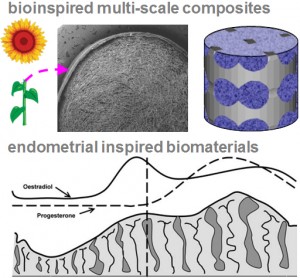 Biomaterials for orthopedic repair must balance competing concerns regarding strength and bioactivity. Taking inspiration from mechanically-efficient composite structures in nature such as plant stems and porcupine quills, we are demonstrating approaches to integrate high-density and high-strength structural elements inside collagen biomaterials to balance strength and bioactivity. We have developed periodically-perforated collagen membranes to increase tensile strength of a class of biomaterials for tendon repair. We are pioneering approaches to create more complex multi-scale composites, using 3D printing to generate patient-customizable fiber and open-cell foam based-networks to mechanically reinforce our scaffold designs.
Biomaterials for orthopedic repair must balance competing concerns regarding strength and bioactivity. Taking inspiration from mechanically-efficient composite structures in nature such as plant stems and porcupine quills, we are demonstrating approaches to integrate high-density and high-strength structural elements inside collagen biomaterials to balance strength and bioactivity. We have developed periodically-perforated collagen membranes to increase tensile strength of a class of biomaterials for tendon repair. We are pioneering approaches to create more complex multi-scale composites, using 3D printing to generate patient-customizable fiber and open-cell foam based-networks to mechanically reinforce our scaffold designs.
Biotransport is a major challenge in tissue engineering. We are exploring approaches inspired by the endometrium, the uterine lining which sheds and regenerates mature vascular networks fifty to 450 times across a woman’s life. Endometrial remodeling is regulated via spatial and temporal gradients of ovarian hormones (estradiol, progesterone). We are developing a class of collagen biomaterials that controls spatio-temporal presentation of these hormones as a new approach for templating pro-angiogenic responses.
advancing reproductive health
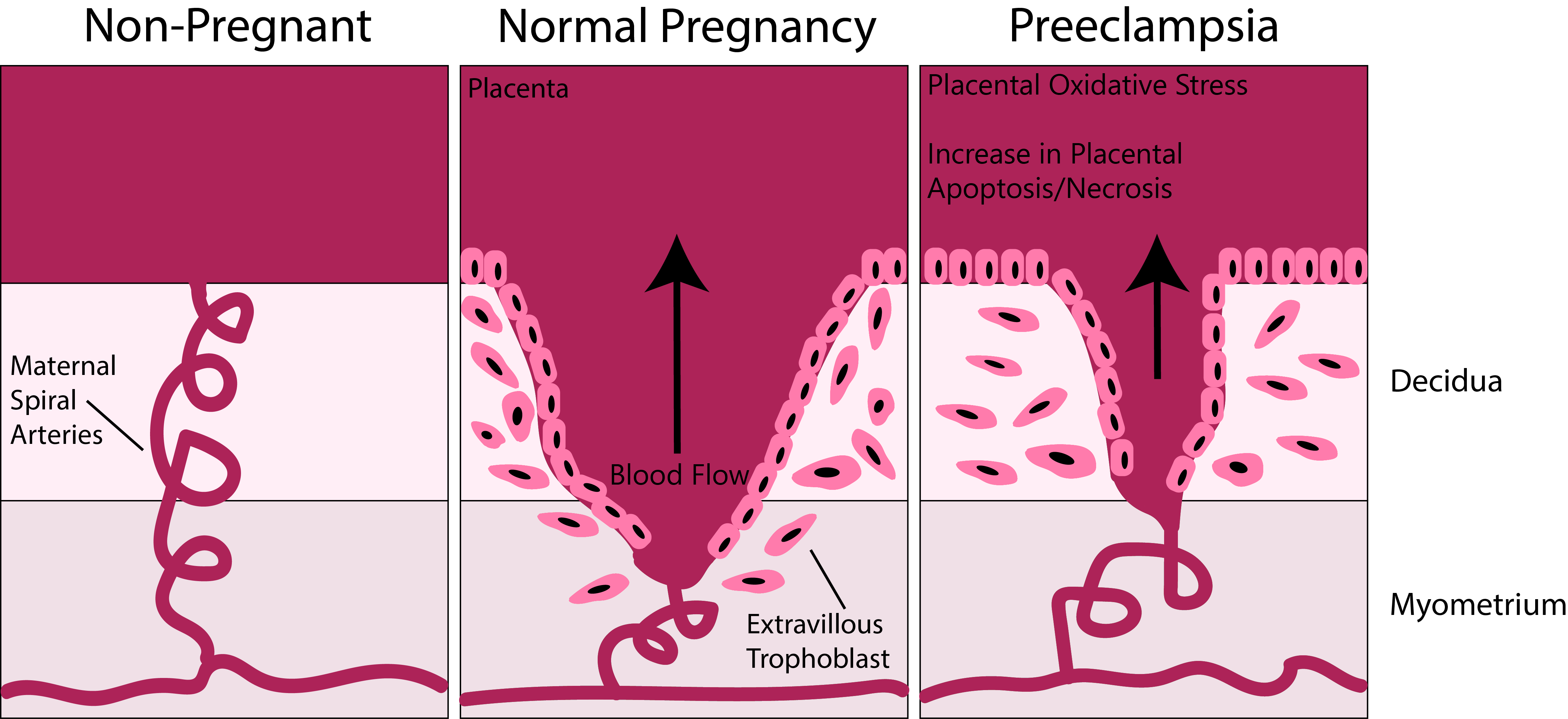 Hypertensive pregnancy disorders, such as preeclampsia, affect approximately 10% of pregnant women around the world and are responsible for significant detrimental effects on both maternal and fetal health. Tissue engineering models of the endometrium, the lining of the uterus and site of embryo implantation, may provide unique opportunities to ask questions about the cellular mechanisms of pregnancy and pregnancy disorders as well as a range of disorders and diseases associated with the endometrium, including endometriosis, a painful disorder in which endometrial tissue grows outside of the uterus, and endometrial cancers. We are exploring 3D biomaterial approaches to study vascular formation and trophoblast invasion in vitro as they relate to pregnancy and preeclampsia using heterotypic cell populations and relevant hormonal cues.
Hypertensive pregnancy disorders, such as preeclampsia, affect approximately 10% of pregnant women around the world and are responsible for significant detrimental effects on both maternal and fetal health. Tissue engineering models of the endometrium, the lining of the uterus and site of embryo implantation, may provide unique opportunities to ask questions about the cellular mechanisms of pregnancy and pregnancy disorders as well as a range of disorders and diseases associated with the endometrium, including endometriosis, a painful disorder in which endometrial tissue grows outside of the uterus, and endometrial cancers. We are exploring 3D biomaterial approaches to study vascular formation and trophoblast invasion in vitro as they relate to pregnancy and preeclampsia using heterotypic cell populations and relevant hormonal cues.
Inclusive science – impacting our community
 Our mission is to actively recruit and train a diverse population in science, technology, engineering and math (STEM). Biomaterials and tissue engineering studies require training in multiple fields, including materials science, biochemistry, cell biology, animal science, and imaging. The nature of this work provides an ideal interdisciplinary environment for trainees to gain the skills and confidence to address emergent challenges at the intersection of the biological, physical, and quantitative sciences. We are committed to creating and modeling a program of education, mentoring, and research opportunities that actively promotes inclusivity and models best practices for developing 21st century scientists.
Our mission is to actively recruit and train a diverse population in science, technology, engineering and math (STEM). Biomaterials and tissue engineering studies require training in multiple fields, including materials science, biochemistry, cell biology, animal science, and imaging. The nature of this work provides an ideal interdisciplinary environment for trainees to gain the skills and confidence to address emergent challenges at the intersection of the biological, physical, and quantitative sciences. We are committed to creating and modeling a program of education, mentoring, and research opportunities that actively promotes inclusivity and models best practices for developing 21st century scientists.
we gratefully acknowledge the financial support that makes this work possible

